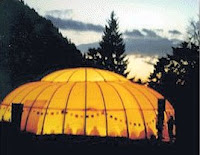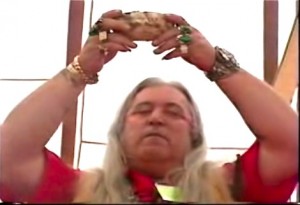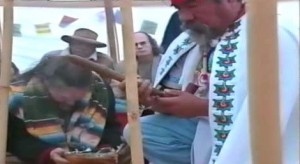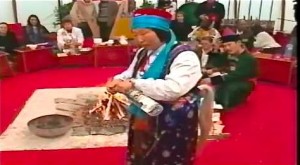 |
The documentary Fire on the Mountain: A Gathering of Shamans was filmed in 1997 at a ten-day gathering of tribal elders, wisdom keepers, and medicine women from five continents, who had travelled to Karma Ling, a Tibetan Buddhist retreat center in the French Alps, to discuss their concerns with the Dalai Lama and representatives of the world’s religions.
The project had begun when Lama Denys Teundroup, the spiritual director of Karma Ling and Honorary President of the European Buddhist Union, was traveling in Ecuador, giving Buddhist teachings, and was invited by poet Alexis Naranjo to journey with him into the jungle to visit the Shuar. There Teundroup met Shuar shaman don Hilario Chiriap, and the two men quickly became friends. Teundroup was struck by the Shuar reverence for nature and its similarity to the Buddhist concern for the welfare of all sentient beings.
Don Hilario voiced his concern about the impact of deforestation and oil and mineral exploration on the rainforest, and expressed his wish for an international gathering where indigenous shamans from around the world could meet each other, present a united message to representatives of the world’s organized religions, and challenge them to take up the environmental cause on spiritual grounds.
 |
Six months later, Teundroup sent out the first invitations for an interfaith gathering “to explore the common themes of peace, compassion, and solidarity which underlie the world’s faiths, and to draw attention to the endangered spiritual traditions of Indigenous Peoples, whose holistic ecological wisdom and social insights have so much to offer the modern world.”
One of the first to accept the invitation was the Dalai Lama. “From my personal experience, I believe such a gathering should have two major objectives,” he wrote. “The first is that the world’s principal traditions consider how to participate in the improvement of the world and of Humankind as a whole, by promoting fundamental human values such as compassion and ethics. The second objective is that each of these major traditions consider how to contribute to the preservation of different ancient traditions which are working for the well-being and survival of their own communities.”
 |
The brochure for the Gathering said: “The monotheistic religions descended from Abraham, Judaism, Christianity and Islam, together with Hinduism and Buddhism, now communicate with each other through a deepening interfaith dialogue that is actively engaged in the development of peace and the promotion of universal values. If these religious traditions, through some of their representatives — in their differences, oppositions, or rivalries — become factors of war, then their dialogue in respect of the difference of each one, is on the contrary the true source of a profound peace.”
The gathering, which ran from April 26 to May 2, 1997, was offically held as part of the United Nations 1995–2004 Decade of Indigenous Peoples. The ceremonies included Buddhist and Bön rituals from Tibet, a tree blessing by a shaman from Tuva, a healing ceremony by a woman shaman from the Buryat Republic, a Voudoun ceremony from Benin, shamanic rituals by a Shuar shaman, prayer rituals by the elder wisdom-keeper of the endangered Rendille nomads of Kenya, a night-time celebration where a Purupecha medicine man of the Native American Church performed the Ceremony of the Four Colors, and other ceremonies performed by representatives of the North American Tlingit, Onondaga, Apache, Mohawk, and Cherokee peoples.
 |
As these indigenous spiritual leaders performed their ceremonies, they realized how much they had in common — a loving respect for the natural world, belief in the importance of dreams, the persecution and suffering of their people, and a determination that the old ways be preserved for future generations.
This private part of the gathering was followed by a public event where the Dalai Lama and the shamans shared their conclusions with high-level representatives of the world’s organized religions, in front of an audience of five thousand people who had spent the previous four days listening to the Dalai Lama’s teachings on the Four Noble Truths. The official photographer was Henri Cartier-Bresson. A book has been published about the gathering — Le Cercle des Anciens: Des hommes-medecine du monde entier autour du Dalai Lama, by Patrice Van Eersel and Alain Grosrey.
The documentary film was produced and directed by award-winning filmmaker David Cherniack, and is available for purchase from Mystic Fire Video. The documentary has been made available on the Web in its entirety.

- Previous Post: Long-Term Peyote Use
- Next Post: Magic Stones
- More Articles Related to: Books and Art, Sacred Plants, Shamanism, The Medicine Path



Don Hilario and his son Nase guided my first Ayahuasca experience during the Easter weekend, few weeks ago. This was one of the most beautiful, respectful, truthful and loving experiences of my life and I’m really glad I made the choice to participate. A climax after a long journey down the rabbit hole. I have been listening to Don Hilario’s icaros frequently lately before I go to bed to relax. Both him, his son and the other people were great people and I can hardly wait until the next journey, also because I have some work to do.
This blog is beautiful in design and content and I’m glad I found it.
It seems like a blog I will keep reading. Thank you.
Some sources on Ayahuasca to share:
Don Hilario Chiriap
http://www.youtube.com/watch?v=OgN1cuODptg
Miguel Chiriap
http://www.tsunki.com
Jacques Mabit
http://www.youtube.com/watch?v=TKFy7pCL5fw
http://www.takiwasi.com
Nosis (trailer)
http://www.youtube.com/watch?v=ql1kNKTGXDI